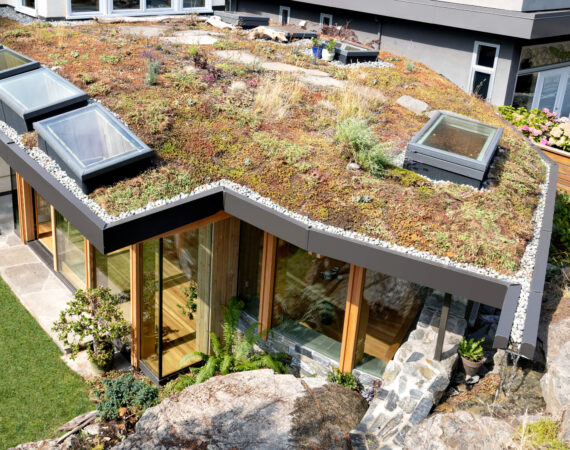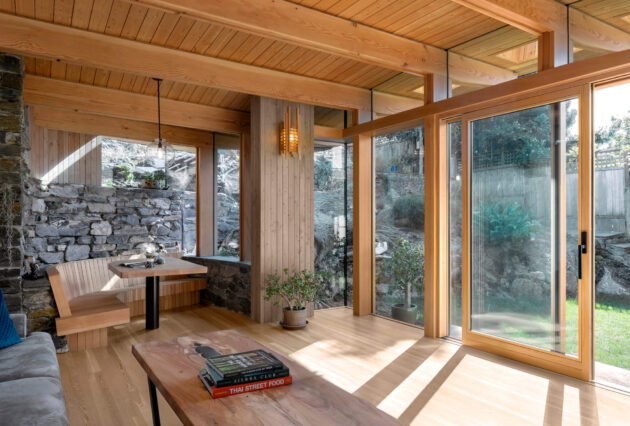

Photo courtesy of Tony Colangelo.
Taylor McCarthy, owner of Frontera Homes in Victoria, B.C., joins Canadian Contractor to share the secret recipe for his team’s award-winning build, “The Irving Grotto” – a remodel with a green roof — and their high-efficiency renovation, “The Fernwood Net Zero.”
Please tell us about the origins of these massive, striking renovations.
With The Irving Grotto, the existing house was nothing special architecturally – an older stucco house in a beautiful part of town with gorgeous views of the ocean. Bruce Greenway of Greenway Studio was the designer, with whom we’ve worked before. Landscapes are the driving force behind his designs. We added a family room/dining room that abuts a cliff, with an entranceway tucked into the stone.
One of the challenges we faced was that we couldn’t find a window supplier that had a thin enough rail style that Bruce was happy with, so we essentially built the windows. We bought the glazing, then we had to rout and rabbet all the posts to fit the glass in and install the trim work on top of that. It’s not only tricky; it’s risky. We incorporated a curved wooden bench on the inside that fits perfectly against a masonry wall in behind that follows the natural rock structure. There were a lot of materials meeting together.
For the Fernwood Net Zero, the clients were a couple from Chicago, and they interviewed several other contractors before they hired us. I think we got the job because we had that hybrid: being able to execute the traditional character finishing they wanted, while making it as green as possible.
The architects had never done anything green like that before, but they created a wonderful design. So, between our experience and the energy modeller we hired, we thought, if we add a few things we can knock this out of the park and make it a net zero. And in the end, we did, and this building produces a heck of a lot more energy than it consumes.

Photo courtesy of Tony Colangelo.
I wonder what role the rugged BC landscape plays into your designs, your clients, your staff, and your mission of high-efficiency, environmentally sustainable projects. How would your company look different if it were in Manitoba or the East Coast?
When I finished university, I had already worked for years as a carpenter in Montreal and Ottawa, and I had always been interested in sustainability — as broad as that sounds. I got my LEED accreditation and thought I could dovetail that into building green homes and so forth. I started working as a sustainability consultant for a big developer in Ottawa. The reality was I mostly chased sub trades around for paperwork.
I did the Heritage Carpentry and Joinery program through Algonquin College out of Perth, Ontario and worked a few years in Ottawa after that. People talked about building green, but we never had clients approach us and say, “we’d like to go Passive, or we have LEED goals.” Nothing like that.
But when I moved to Victoria, it was completely different. Victoria’s climate makes it much easier to achieve those efficiency targets. There’s more of a green slant out here, I mean, the Green Party is from Salt Spring Island essentially, right?
I put myself through Passive House training, and I’m about to put one of my carpenters through Passive House training, as well as another guy. There are a lot more discussions about these types of things. I’m sure it’s happening in Manitoba or Ontario as well, but it’s twofold — there’s the interest we as carpenters have in this type of building, and there’s the client interest as well.
We have a project coming up. It’s an older character home for a retired couple. We’re lifting the house, removing the siding, adding exterior insulation, wrapping the house in an airtight envelope. We’re going to get pretty darn close to Passive with an existing house, which doesn’t happen very often. But they’re willing to spend a little more and take the extra time to go through an integrated design process.
Your website mentions heritage restoration and the cultural value of homes. What are your aims with that type of work?
I do think history is important to any town in Canada. We’re still a fairly new country, so wherever we can save something that’s significant to our heritage, I think that’s important. If you look around at any city that has old character homes like Montreal, or Ottawa, or Victoria, there’s a heck of a lot more 1950s, 60s, 70s stucco, concrete, kind of drab homes than there are these beautiful old wood homes, which are the ones that interest me.
These character homes have already stood for 100 years and if there are no major structural issues, I believe it’s better to keep these homes than to landfill them. If you can find the right clients with the same priorities, it’s really worth it. Aesthetically, they stand the test of time. They’re beautiful, they’re classic, and they always will be beautiful. I admit I’m biased towards old wooden homes, but they give neighbourhoods a value that you can’t put a price on.
Does having a niche help or hurt you?
When you have a niche, you want to be better than average, if not the best. And if you’re up there in the top tier, you’ll have work coming to you. And I’m not saying we’re the best, I can promise you we’re not – I totally look up to a lot of other builders. But you hear a lot about boutique hotels, right? We’re like boutique craftsmen. We have great clients, we do beautiful work on interesting jobs that win awards, and we’re doing well.
The other thing about a niche is you really have to love your niche. In a perfect world, each year we would do one Net Zero or Passive-driven new build — just as green as you can be. And then one large heritage restoration that added some green elements but really focused on traditional trim and stain-grade carpentry. Someone may call us for a character build, but they don’t care about installing solar panels or an airtight barrier, or triple pane windows. On the other hand, we just did a very green project, but it was a super modern square box. We liked it, but from a finishing standpoint I wouldn’t say my trim guys found it as challenging as an older character home. They’re not always in the same conversation, so we don’t want to niche ourselves to just be the heritage guys, or just be the green guys.
How big is your company and how many projects a year do you take on?
It’s myself and anywhere between six and eight carpenters. We’re a company of 10 and under. We predominantly have two larger, year-long projects per year, and then three or four smaller renovations that range between three weeks to a few months. I don’t really see much need to grow. I definitely don’t have any dreams of being a massive company because I really love the craft, and being detail-oriented, being on-site with the guys, chatting with the owners and architects — being part of the process.
There will probably be some inevitable growth. Maybe a few more people for larger scale jobs, and a couple people helping with administration. I always thought that being a design/build firm would be interesting, but that, also in itself is a niche, and then you’re always working with the same types of design. I think we all prefer to work with different architects, designers, new people — of course we’ll take return clientele, but we like to change things up and keep it interesting for ourselves.
When you reflect on your career, what are some key points you learned along the way?
Somebody told me once, “you have to make your own passion.” Everybody has this point in their career where they’re feeling bored or stuck. The beauty of carpentry is there’s always room to do something different.
When I was working in Montreal, I was stuck in a loop working for a contractor doing kitchens and bathrooms and kitchens and bathrooms. I remember walking up three flights of stairs in the middle of winter with a mitre saw in my hands, worrying about parking, and just thinking, “what am I doing? Is this it for the rest of my life?” It was just by chance that I came to Victoria and that transition really renewed my passion for what I thought carpentry could be.
I’m not saying you have to stop working or go back to school for 10 years. But if you’re willing to do a night course in something you’re interested in — like timber framing, or woodworking where you learn wood types, stain types, or different styles of joinery — these are the types of things that can drastically change your outlook on something and renew a passion and maybe lead to that next step that you need.

Leave a Reply